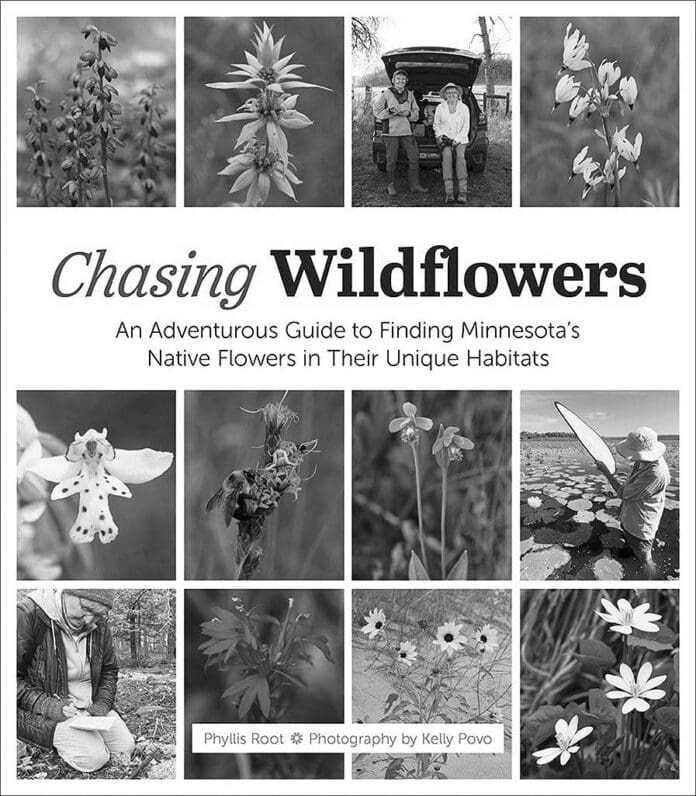On a recent road trip to the East Coast, I had the unexpected pleasure of watching the landscape slowly shift, state by state, mile by mile. Our destination was the Catskill Mountains of New York, but the journey became something more: a study in changing flora.
From the thick forests of Wisconsin to the sandy stretches of Michigan, through Ohio’s farmland and Pennsylvania’s wooded hills, each region offered its own palette of green, some deep and shaded, others sun-bleached and spare. I found myself especially drawn to what grew along the highway shoulders, those wild and unplanted bits of nature that quietly define a place.
Wildflowers were already on my mind. Before the trip, I’d received a copy of Chasing Wildflowers: An Adventurous Guide to Finding Minnesota’s Native Flowers in Their Unique Habitats. The book is the latest from writer/photographer duo Phyllis Root and Kelly Povo, a follow-up to their earlier title Searching for Minnesota’s Native Wildflowers: A Guide for Beginners, Botanists, and Everyone in Between.
As you flip through Chasing Wildflowers, it feels less like reading and more like tagging along—tramping through bogs, brushing past prairie grass, marveling at the unexpected. That sense of shared adventure is no coincidence. Root and Povo designed it that way.
“When I’m writing, I feel like I can take people along with us,” explained Root, who has authored more than fifty books, most of them for children. “So, I try to include little stories, maybe about a flower or a moment. It’s to say, ‘Come along, you might want to do this yourself. You can’t love what you don’t know about.’”
“Our audience is people like us—interested in the natural world, not necessarily botanists,” Povo added. “So we try to make it easy and fun.”
Friends since the early ’90s, Root and Povo were self-employed single mothers who made a pact to check in weekly, holding each other accountable for the goals they set each week.
“It just really built such a strong foundation for our friendship,” reflected Povo.
While Root was working on a book about habitats for the University of Minnesota Press, the two took a road trip to Big Bog State Recreation Area—a place known for its mile-long boardwalk that lets visitors explore the largest peat bog inside the lower 48 states.
“We learned that Minnesota has more peatlands than any other state besides Alaska,” Root said. “That’s incredible to us. You know about all the lakes, but peatland is everywhere in northern Minnesota. We kind of became enchanted with learning more about it.”
Povo, who admitted her photography work up to that point had nothing to do with flowers, was equally impressed.
“You go to the end of the boardwalk, it is like the quietest, wildest place I had ever seen, and I’ve seen some wild places,” said Povo. “It was kind of amazing for me as a photographer, just to look at some of these plants and photograph them for the first time.”
After many more road trips and countless photographs, they realized they might have a book in the making. Searching was published in 2018, and Chasing naturally followed.
“Some of the flowers in the second book are rarer,” Root explained. “We really were chasing them, learning where and when they bloom.”
One memorable chase centered on a rare cactus native to western Minnesota, one that required several trips just to catch its fleeting bloom.
“We literally were running to catch it before it closed,” said Povo. “The flower closes after about an hour.”
Hearing this story from the two friends feels almost magical. They described the mesmerizing moment when a bee landed on the flower—and watched as it slowly folded closed around its tiny visitor. (No worries—their follow-up visit the next day confirmed the bee was safely free and unharmed.)
Neither the author nor the photographer are botanists or biologists, which gives their book a fresh and approachable perspective. Over the years, they’ve learned a great deal, including that Minnesota is home to 45 visible orchid species, all of which they’ve discovered on their journey.
They were surprised to learn that Minnesota is home to carnivorous plants, including four types of sundew. These delicate sundews, in particular, captivated them.
“We’re still trying to see them all,” Root said. “They’re beautiful. When the sun hits them, they sparkle.”
Earlier in July, Root and Povo visited Drury Lane Books in Grand Marais to talk about their new book. They enjoy these events as opportunities to share stories and often find readers eager to share theirs in return.
The event also included Cheryl Anderson, who, according to Root, “vetted the North Shore chapter of our book and helped make sure we weren’t saying anything wrong.” Root described Anderson as “not only knowledgeable, but also gracious.”
“It was great to meet her in person,” Root said. “Betsy Bowen came, too. She’s illustrated books I’ve written, so that was fun as well.”
The events often spark lively conversations about their favorite finds in the field. Though they have a hard time picking a favorite flower, both agree that the Western Prairie Fringed Orchid was a truly special find.
“It’s so rare,” Root said. “We saw it once, and then never again. We felt lucky and privileged to see it when we did.”
“It took years to find it,” Povo added. “Even when we did, we searched for hours in a small area before spotting it. It’s one of the rarest plants in the state.”
With spending so much time in the remote wilderness, one major concern for the pair has been getting lost but they’ve developed a clever strategy to help them find their way back.
“Some places have no landmarks,” Root said. “So we started using bright flagging tape from the hardware store. Kelly goes ahead, I tie one, she waits until she can barely see it, and I catch up. We count every tie going in so we can untie them on the way out.”
Other challenges include bugs, which the two swear can be kept at bay by their recommended “Bug Shirts,” and occasionally sinking deep into muck.
Root shared a memorable story about exactly that—getting stuck deep in the muck during one of their wildflower adventures.
“We were hurrying along a road after leaving the tiny cedar forest when a storm started rolling in. On the way in, Kelly had stepped into mud up to nearly the top of one boot, and we got her out. But on the way back, in my rush, I stepped in with both boots—mud nearly reaching the top,” she laughed. “I learned a trick to get your boots out of the mud, or I probably would have had to abandon them right there.”
Beyond the hazards of mud and bugs, another challenge the pair often encounters is photographing their wild subjects.
“My biggest struggle is dealing with wind and sun,” Povo said. “I love the prairie, but it’s the hardest place to get great photos because it’s so windy.”
To combat the sun, Povo uses a special lens and tries to diffuse the sunlight. Sometimes Phyllis literally has to step in to provide shade.
“A lot of times she has to hold the shader,” the photographer said. “Sometimes, she is the shade!”
Povo has a keen eye for capturing a wildflower’s unique characteristics, and even its distinct “personality.”
“I’m not really going for an ID shot, hence I don’t always have the entire flower in focus,” Povo said. “Sometimes I want the leaves and bloom in focus. I have to use a couple of photography techniques to make that happen. But it’s definitely my goal to show and capture the personality of that particular native plant.”
This is something Povo does exceptionally well. Paired with Root’s vivid descriptions and the stories attached to each flower, their book becomes much more than just an identification guide—it’s an invitation to get outside and start chasing wildflowers ourselves.
“We would really love it if people went out and looked for wildflowers, too,” Root said, speaking to her readers.
“The whole point is to get people excited about going out, exploring, finding the places they love, and sharing those experiences with family and friends,” Povo said. “The more people know about these things, the more likely they are to love and protect them. That’s really our goal. We live in a state with diverse biomes, and we’re rich. Rich in wildflowers.”
I can personally attest to this richness on my return trip home. As Minnesota shifted into July and the wildflowers burst into full bloom, they lined the highways in joyful, disorganized patches with golden black-eyed Susans, delicate Queen Anne’s lace, purple clover, and brilliant bursts of bee balm to name just a few in my view. Compared to the stretches of roadside we’d seen elsewhere, Minnesota’s wildflowers were not just present, they were thriving. It felt as if the ditches themselves were throwing a vibrant homecoming party.
There’s something deeply comforting about returning home and being greeted not by signs or skylines, but by a natural banner of color. Among the five states we traveled through, Minnesota’s wildflowers stood out as the most colorful and plentiful. And those were just the ones lining the roadside. Inspired by my new wildflower friends, I’m planning to get out there myself, both searching for and chasing the treasures that Minnesota’s landscapes have to offer.
To learn more about Root and Povo’s adventures, visit their blog Flower Chasers at mnnativewildflowers.com. You can also explore more about Root and her many books at phyllisroot.com, and browse or purchase Povo’s photography at kellypovo.com.








